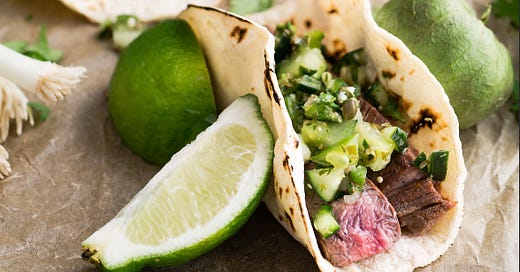Tacos-as-a-service? Curious. 🌮
Prime Future 82: the newsletter for innovators in livestock, meat, and dairy
Taco Bell has been testing a subscription service: $10/month for 1 taco every day.
Set aside concerns for subscribers health and the egregious assault on tacos that is Taco Bell, the idea of Tacos-as-a-Service is kinda interesting.
Tacos-as-a-Service is proof that recurring revenue models are no longer confined to the tech industry.
Salesforce pioneered Software-as-a-Service (SaaS) by jumping on the cloud based software trend in its early days. Recurring revenue is now the preferred pricing model for software companies and their investors, but it's a model that has spread to other types of business from hardware to....tacos.
Recurring revenue pricing models are awesome. They create more predictable revenue, which helps companies plan and scale more predictably than a business model built around one-off transactions. Recurring revenue means decreased customer acquisition costs (CAC) which increases the value of that revenue from a company valuation standpoint. And recurring revenue is great for customers, as would be capital expenses get moved to the income statement. Anything-as-a-Service models also allow for more flexibility from a customer standpoint.
We don't see many recurring revenue businesses in agriculture, except for software and (some) hardware. And it makes sense that agriculture is a transaction based industry since inputs like fertilizer, seed, and feed are all physical things that have fixed and variable costs associated with producing 1 more unit of stuff.
But so do tacos.
If Taco Bell (and a growing number of non-digital companies) can build an effective subscription service of a physical good, who’s to say we won’t see…
Feed-as-a-Service?
Genetics-as-a-Service?
Processing-as-a-Service?
What would need to be true for subscription pricing models to be economically sustainable for companies selling physical goods?
Taco Bell said that the subscription service “grew its rewards program by 20%.” I’ll bet you a crunchy taco that there’s a team of Taco Bell pricing analysts who know the precise expected impact on Customer Lifetime Value of each enrollment in a rewards program, all of which factors into the equation of why the subscription pricing model works.
Maybe Taco Bell's foray into subscription pricing is another PR stunt. Or, maybe this is a sign that subscription pricing is rapidly expanding beyond digital products and we are on the cusp of more business model innovation, even in livestock, meat & dairy.
Now set tacos aside, let’s talk tractors.
John Deere announced the upcoming launch of “a fully autonomous tractor that's ready for large-scale production.”
“To use the autonomous tractor, farmers only need to transport the machine to a field and configure it for autonomous operation. Using John Deere Operations Center Mobile, they can swipe from left to right to start the machine. While the machine is working the farmer can leave the field to focus on other tasks, while monitoring the machine's status from their mobile device.
John Deere Operations Center Mobile provides access to live video, images, data and metrics, and allows a farmer to adjust speed, depth and more. In the event of any job quality anomalies or machine health issues, farmers will be notified remotely and can make adjustments to optimize the performance of the machine.”
Much analysis has been done around the implications of this announcement, so all I have to say after watching the range of takes from farmers on ag twitter is this:

The age old skepticism-to-belief curve, aka the adoption curve, closely links to our final thought today.
We're <2 weeks into the year with potential new food pricing models and potential new farm operating models, yet I received this message:
I am keenly aware that writing publicly means you’ll see many of my hypotheses proven wrong, like ‘Peak Oil by 1950’ level wrong.
Actually the only thing I'm 100% confident in is that I am wildly underestimating the actual change we will see. The gap between Here and There will be significant, whether There is 1, 10, or 100 years from now.
Although it’s true that identifying what is not going to change is important, this is a newsletter for innovators in livestock, meat & dairy. The whole purpose of this newsletter is to spark & attract conversations about emerging trends and how those trends create opportunities.
The gap between Here and There, where emerging trends are still emerging, is where innovative companies, brands, and leaders live…
…as long held assumptions no longer hold, as supply chains reorganize, as tech changes production methods & unlocks new business models, as consumers segment by new values.
I think of it like this: Traders love volatile markets, whether it’s the stock market, livestock market, or any other market. If markets are stable, traders don’t make money. If markets are moving, traders can make money.
Volatility creates opportunity for traders; trends create opportunity for innovators.
And IMHO, the only way to discern the actual high impact emerging trends from the noise is through dogged curiosity.
Here’s to curiosity & 2022; what a time to be alive 😉
I’ll be at NCBA in February. Let me know who I should connect with!





